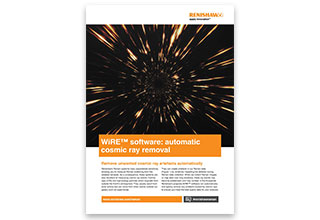Ta strona nie jest obecnie dostępna w Twoim języku. Możesz zapoznać się z tłumaczeniem automatycznym, korzystając z usługi Google Translate. Nie jesteśmy odpowiedzialni za świadczenie tej usługi, ani też wyniki tłumaczenia nie były przez nas sprawdzane.
Jeżeli chciałbyś uzyskać więcej pomocy skontaktuj się z nami.
Cosmic ray removal
Cosmic rays and Raman
If you run long duration Raman measurements you will probably see some sharp spikes in your spectra which are not related to the sample. These are generated by cosmic rays hitting your detector, producing spurious features, which are typically narrower than Raman bands. You can use the Cosmic Ray Remover (CRR) options in Renishaw's WiRE™ software to remove these features from your spectra quickly and easily.
Origin of cosmic rays
Primary cosmic rays are high energy particles from outer space. They produce a shower of particles (secondary cosmic rays) when they hit the atmosphere. These random and unavoidable events generate spurious spikes in the Raman spectra.
Avoid cosmic rays
inVia's design is stigmatic—the spectrum forms a narrow band of concentrated light on the detector. This not only improves signal-to-noise ratios, but also makes inVia less prone to the effects of cosmic rays.
Benefits of removing cosmic ray features from spectral data
- Your data processing and analysis will be easier
- Your data will be easier to interpret
- Spectral band shape can be maintained
- When analysing data using unsupervised chemometric methods, such as principle component analysis (PCA), you can be confident you are analysing solely sample-related data (Raman/photoluminescence)
- Your images will be artefact-free and therefore more representative and attractive
Removing cosmic rays during data collection
You can eliminate cosmic rays with WiRE's median filtering option. This acquires two additional accumulations for each desired spectrum. WiRE then, for each Raman frequency, takes the median of the three values. This automatically rejects cosmic rays of all shapes and sizes as they will always be an extreme value, rather than the median. This approach also reduces noise.
Superficially you might expect this approach takes three times longer to collect the data. However, if you reduce the acquisition time and increase the number of accumulations, then the increase in total experiment time is relatively small.
Removing cosmic rays after data collection
A small number of obvious cosmic ray features can be removed using a simple zap function. This replaces the ray region with a single line. Where we have many spectra within a data file this method becomes impractically slow.
For rapid results on files containing many cosmic ray features, Renishaw's Cosmic Ray Remover processing tool provides a combination of suitable methods. These are applied either fully automatically or with your guidance.
Many aspects of Renishaw's innovative technology are covered by patents.


